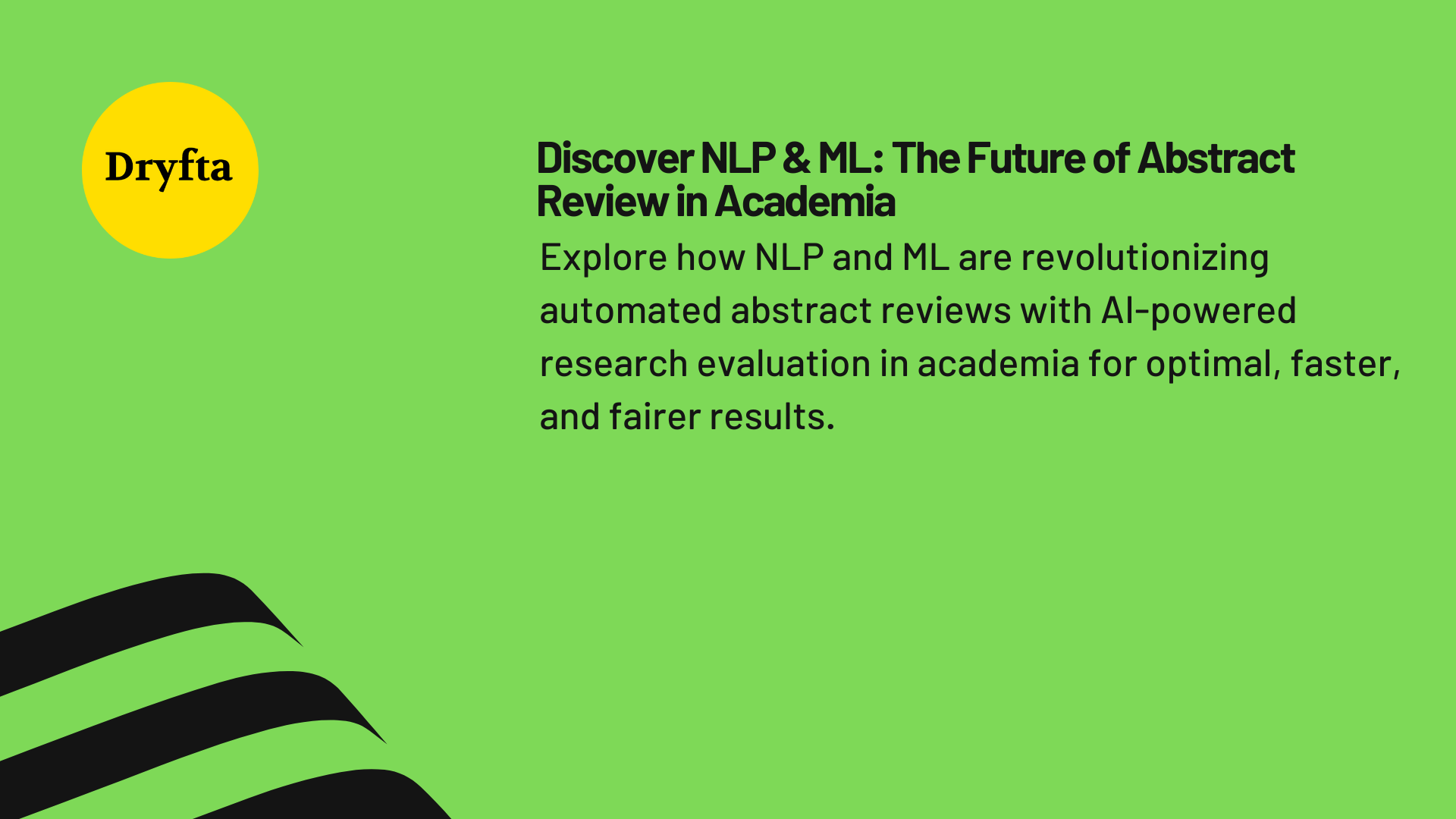
The academic landscape has transformed immensely, and the peer-review process is no exception. Every year, there is an increase in the volume of abstract submissions to academic conferences and journals. Behind every review process lies an abstract, which functions as a first impression of the research. It also acts as a summary that helps the reviewers understand whether a paper requires further attention or not.
Abstract review is the process of evaluating research summaries submitted to academic conferences or journals. Reviewers check these abstracts for quality, originality, clarity, methodology, and relevance to the event or journal themes. The traditional review process for the abstract relies on expert reviewers who read, assess, and score each submission.
The process was labor-intensive and time-consuming. Nevertheless, the latest developments in Natural Language Processing (NLP) and Machine Learning (ML) offer promising ways to improve and speed up the abstract review process. Each year, many submissions pour into academic journals and conferences.
This blog provides clear details on how NLP and ML are revolutionizing abstract review in academia. It discusses the challenges, role, benefits, and the future of the automated abstract review process worldwide.
The Challenges of Traditional Abstract Review
The abstract review process requires human reviewers to evaluate submissions based on relevance, quality, and suitability for the conference or journal. However, this process has several limitations: –
Time-Consuming
Reviewing abstracts can take a long time, especially for large conferences. This not only makes the task tedious but also wastes a lot of time, which can be utilized in other things.
Human Bias
Reviewers may have their own biases that affect the fairness and consistency of the review. This affects the results and sometimes leads to conflicts, which are tough to resolve.
Volume of Submissions
With more submissions coming in, reviewers can struggle to keep up with the demands. Many times, a lot of work goes unnoticed and lost because of mismanagement and no proper backup.
Lack of Clarity
Manual evaluations frequently suffer from a lack of traceability, complicating the explanation of how specific decisions were made. This adversely impacts the consistency, speed, and fairness of the abstract review process.
The Role of Natural Language Processing (NLP) and Machine Learning (ML) in Academia
Artificial Intelligence has already transformed fields such as healthcare, finance, and education. In academia, it is now being used to automate and improve key processes such as plagiarism detection, publication indexing, and reviewer matching. The use of AI-powered research evaluation adds a new aspect to academic review; it allows for large-scale, data-driven analysis of research quality.
It also uses AI algorithms, including Natural Language Processing (NLP) and Machine Learning (ML) models, to evaluate research abstracts based on set criteria like structure, language quality, thematic relevance, and innovation. These systems do not replace human reviewers; instead, they assist by managing the first screening phase, enabling experts to concentrate on more complex evaluations.
The NLP and ML in Academia can help automate as well as improve the abstract review process in several ways. A few of them include:
Enhanced Consistency
NLP-based evaluations use set criteria, removing personal biases or fatigue. This ensures more consistent assessments across submissions and reviewers.
Better Reviewer Support
Instead of replacing reviewers, AI-powered research evaluation tools serve as digital assistants. They summarize abstracts, identify missing elements, and flag unclear sections. This is also useful for the reviewers to make better, wiser, and quicker decisions.
Higher Adaptability
Using modern solutions will help analyze thousands of abstracts in just a short time. This significantly reduces the administrative burden. Conferences and journals can handle more submissions without lengthening review time or requiring additional staff.
Improved Transparency
NLP and ML systems can record how decisions are made. This transparency helps conferences explain their choices, spot bias, and improve their criteria over time.
Data-Driven Insights
Aggregated results from AI-based systems can show research trends, emerging topics, and collaboration networks. This information provides valuable strategic insights to academic institutions.
Advantages of Adopting Automated Abstract Review
Automated abstract review refers to systems that use NLP and ML to analyze academic abstracts automatically. These tools can extract features such as topic relevance, clarity, originality, and structure, all within just a few seconds.
These systems do not replace human reviewers. They act as smart assistants. They pre-screen abstracts, point out potential issues, and provide the reviewers with initial insights. This lets human experts concentrate on content that needs careful judgment.
Efficient Review Process
One of the core advantages of automated abstract review is the faster review cycle. Manual evaluation can take weeks or even months, especially for large conferences that receive thousands of submissions. Automated systems can analyze abstracts in minutes, identifying those that meet certain quality or relevance standards.
By managing the initial screening phase, these tools allow reviewers to concentrate on high-quality abstracts that need human judgment. This ensures that deadlines are met efficiently and that academic events or journals keep their publishing schedules on track.
Precise Results
Modern automated review systems use Natural Language Processing (NLP) to understand language patterns, research context, and meaning. NLP allows machines to interpret abstracts more deeply, looking at coherence, structure, and the scientific tone and clarity of the writing.
Additionally, ML algorithms can be trained with historical data from accepted and rejected abstracts. Over time, these systems learn to predict the likelihood of acceptance with high accuracy. This highlights promising research for human review. Such data-driven precision lowers the risk of missing valuable contributions and ensures the best work stands out.
Affordable Solutions
For organizations hosting large academic events, increasing the size of manual review teams can be costly and complicated. Automated abstract review tools provide a scalable and affordable option, managing thousands of submissions without needing extra human resources.
Institutions can lower administrative and operational costs while keeping, or even improving, the review quality. Additionally, since these systems can work around the clock, they remove geographical and time-zone barriers, making global collaboration easier.
Easy Detection of Plagiarism
As the number of research publications increases, plagiarism detection plays a vital role in reviewing abstracts. Automated systems can quickly compare new submissions with large databases of academic papers, journals, and conference proceedings.
This process identifies potential overlaps, self-plagiarism, or unethical text reused in seconds. Handling this task manually on a large scale would be nearly impossible. This approach helps maintain the integrity of academic conferences and ensures that all accepted abstracts meet ethical standards for originality.
Environmental Sustainability
Automated abstract review minimizes the requirement for paper documentation, printed review forms, and long communication chains between reviewers and committees. This digital process saves time and resources while also supporting environmental sustainability, which is an important consideration in modern academia.
Promoting Inclusivity
Unconscious bias is a common issue in academic evaluation. It often relates to an author’s institution, region, or reputation. Automated systems can be set up to perform blind reviews that focus only on content quality, methodology, and originality. This improves transparency and inclusivity. It helps ensure that research from early-career scholars or underrepresented regions gets fair consideration.
Futuristic Data Insights
Beyond reviewing abstracts, automated tools generate useful analytical data. Organizers can use these insights to understand trends in research topics, identify areas of growing interest, and even improve their future call-for-paper strategies. These analytics help conference committees and journal editors make informed decisions that match academic trends and audience interests.
Assists in Decision-Making
AI-powered research evaluation does not replace human reviewers; it improves their decision-making abilities. Automated systems can provide reviewers with detailed reports summarizing each abstract’s language quality, thematic relevance, and similarity scores. This insight lets reviewers make faster, more informed decisions.
It also reduces cognitive overload during busy submission periods. The outcome is a better collaboration between human expertise and artificial intelligence, which leads to improved academic results.
Applications of Natural Language Processing (NLP) in Abstract Review
NLP enables systems to “read” academic texts and pull out important insights, similar to how a reviewer would do it. The models get their training from large sets of academic papers and abstracts. Its systems can grasp not just what an abstract says. They can also understand how it conveys the research intent and importance. Some of the real-time applications of NLP in abstract review are:
Text Classification: NLP algorithms can classify abstracts by subject area or research domain, ensuring reviewers are assigned appropriately.
Semantic Similarity Detection: Using vector-based semantic models, NLP identifies overlap between abstracts and existing literature. This also easily spots plagiarism or repetitive work.
Quality Assessment: NLP assesses language quality by measuring sentence complexity, clarity, and academic writing style.
Topic Modeling: NLP identifies key themes, keywords, and new research areas. This is useful for the organizers categorize submissions more efficiently.
Sentiment and Coherence Analysis: By examining sentence structure and logical transitions, NLP estimates how clearly ideas are expressed and if arguments are coherent.
Applications of Machine Learning (ML) in Academia
Machine Learning (ML) is a branch of AI that enables systems to learn from data and improve over time without specific programming. In academia, ML models can be trained on past review data to predict how likely it is for an abstract to be accepted or receive a high rating. A few applications of Machine Learning in academia are:
Predictive Scoring: ML models look at factors like linguistic quality, structure, and topic relevance to give a predictive score that shows an abstract’s chance of acceptance.
Reviewer Matching: ML algorithms match abstracts with appropriate reviewers based on their expertise. This ensures that submissions are assessed by the most qualified professionals.
Pattern Recognition: It finds common traits among papers that were accepted before. This is useful for making evaluations fairer and more consistent.
Bias Reduction: By concentrating on data-driven factors instead of human judgment, ML helps lower bias in academic decision-making.
Continuous Improvement: As ML systems analyze more data, their predictions and recommendations become more accurate. This offers continuous updates when it comes to evaluation standards.
An Example of NLP and ML in the Process of Automated Abstract Review
A university organizes an academic conference. It receives 5,000+ submissions. Now, using the NLP and ML systems helps automatically create an ecosystem for automated abstract review. This system successfully eliminates off-topic or low-quality abstracts, ranks the top 20 percent of submissions for further human review, and provides insights on the latest research trends.
In this AI-powered research evaluation system, NLP extracts, analyzes, and structures textual data and identifies thematic and linguistic elements. Whereas ML identifies patterns, learns from past reviews, and produces possible predictions. It also determines the importance of statistics and predictions. The combination of NLP and ML systems offers a holistic evaluation, which is very efficient, accurate, and highly scalable.
Dryfta offers a great research evaluation system. Whether the academic conference consists of 300+ or 5,000+ participants, Dryfta’s event app ensures end-to-end support.
Ethical and Practical Considerations
Although automated abstract review enhances efficiency, A few ethical and practical considerations remain crucial:
Data Privacy – Protecting author data and intellectual property is essential.
Avoiding Algorithmic Bias – AI must be well-trained with diverse datasets to avoid inherited bias.
Maintaining Human Oversight – AI should assist, not replace, human experts’ judgment.
Transparency – AI systems must provide explainable results to build trust.
Looking ahead, NLP and ML are set to advance further. Future systems will handle multilingual abstracts, recognize interdisciplinary themes, and even predict emerging research fields. Hybrid AI-human collaboration will become the norm, balancing computational precision with human insight.
Final Thoughts
The combination of NLP and ML is changing how research is evaluated in the abstract review. With automated abstract review and AI-powered research evaluation, academia is shifting toward a more open, fair, and data-based approach to decision-making.
These technologies not only make the review process easier but also help institutions gain insights, promote inclusivity, and maintain academic integrity worldwide. As we enter this new era, the partnership between human knowledge and artificial intelligence will shape the future of academic excellence. In this future, every idea, no matter where it comes from, will have a fair chance to be recognized and celebrated.




